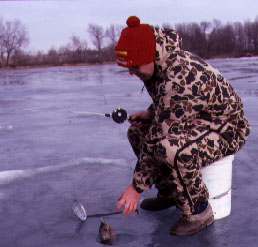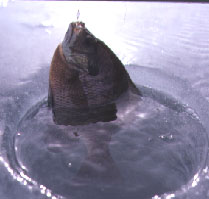|
|

|
 |
 | ||
The 10 Commandments Of Ice Fishing
Since that frigid day when I first waddled onto Iowa's ice covered lakes, I've attempted to master the fine art of ice fishing. I'm not really sure why people ice fish. Perhaps it’s because it's one of the few outdoor activities in the middle of a cold, northern winter. However, over the years I've developed 10 simple rules, the 10 commandments of ice fishing so to speak, that allow beginner or expert to maintain a professional image while ice fishing. Although Toad now fishes from the great fishing water in the sky, much of what's contained here comes from Toad's experience. Rule #1: Wear proper attire. Ice fishermen dress code dictates that three shirts, two sweaters, one jacket, and one coat be worn on even relatively warm days. On colder days, the rule is to add clothing until your arms stick out at 45 degree angles. You should wear felt-lined boots, but not snowmobile boots. Snowmobilers and ice fishermen don't always get along. Wear at least three pairs of socks (under your boots). Wear a stocking hat. A couple ice jigs stuck firmly into the hat and protruding into your head will keep your hat from blowing off. All professional-looking ice fishermen wear wool gloves with the last two inches of fingers cut off. For added piece of mind, wear thick ear muffs so you don't hear the ice crack as you walk about. Rule #2: Use proper equipment. The most important piece of equipment is a white five gallon plastic bucket with a carrying handle. Tackle boxes are not allowed. The bucket is used to store equipment in, to throw fish in, and to sit on. You need an ice auger to cut a hole in the ice. A hole 1-1/2 inches across will accommodate almost any fish you'll likely catch, although ice fishermen always drill at least a 6" diameter hole so that they look more professional. Use an old fashioned ice auger. Those with loose, dull blades help keep you warm as you strain to drill that one lucky hole. You'll also need an ice scooper to remove loose ice from the hole ... or use a slotted spaghetti spoon, which is effective, but borders on being low class.
Rule #4: Choose the best bait. For panfish bait, I use wigglers. Some prefer "mousies" or "rattail maggots", but wigglers are my first choice. They hold up better on the hook and don't sound as repulsive as these other baits. (Wigglers are actually a nice name for a fly maggot.) For walleye or pike, use 1-5" long minnows, creatively called walleye or pike minnows. (Check local regs. to be sure this is legal in your area.) Or, if you have an aversion to using bait, use a tiny jigging spoon. Rule #5: Check out the ice. Assemble your modest boat load of equipment, load it in your bucket and before lumbering out onto the ice, look around for other fishermen. If you don't see these early-bird fishermen, the ice isn't thick enough yet. You must carry all your equipment by hand or wear it on your back. Only wimps (as Toad called them) tow their gear on a sled ... and a snowmobile is simply out of the question. The new portable ice houses (which are okay to tow) can also hold your gear ... and these are acceptable. Rule #6: Find the best spots. To find the best spot, half slide, half walk (called the ice shuffle) until you arrive at a spot somewhere near the middle of the lake. It takes years of savvy to find these hot spots. Toad watched for certain subtle clues, such as 30-40 other ice fishermen, especially those he'd see catching fish. Drill a hole next to a guy who's really catching them, or better yet, talk him into using one of his spare holes. (For this to work, it helps if you're a big person.) Rule #7: Be prepared for action. After drilling and cleaning the ice from your hole, sit on your five gallon bucket and wait for the action to start. Meanwhile, jig your bait up and down, up and down, until a fish happens by and grabs your bait. Rule #8: Keep the excitement going. If the action is slow (usual), lay on the ice and look down into the hole to verify if fish are anywhere around. You really look professional now. Be sure to keep fishing as though you're seeing all kinds of fish. Every once in awhile make up a story about a big one getting ready to take your bait, and set the hook as though it actually tried. It's your obligation to keep others around you excited. Rule #9: Catch your limit. Or, if you can't catch your limit, use a trick Toad taught me. Keep four or five frozen fish (you previously caught) in your bucket. That way it never looks like you've gotten skunked. Rule #10: Recover. After sitting on your five gallon bucket or lying on the ice all day, you’ll find it helpful to drink liberal quantifies of hot buttered rum (after arriving home). Allow two days of rest to prepare yourself for another trip next weekend.
An America Outdoors Feature. All Rights Reserved. |
|
|
| Site design by Outdoor Management Network Inc. Copyright © 1996 - 2007 Outdoor Management Network Inc. America Outdoors® is a registered trademark of Outdoor Management Network Inc. |
 It was 34 below zero when I moved from Michigan
to Spirit Lake Iowa, during the winter of '82. The
wind chill was 95 degrees below zero, and even ice
bunnies shivered in their burrows. However, in four
short days, I was to be ice fishing. At least that's what
my new friend Toad called it.
It was 34 below zero when I moved from Michigan
to Spirit Lake Iowa, during the winter of '82. The
wind chill was 95 degrees below zero, and even ice
bunnies shivered in their burrows. However, in four
short days, I was to be ice fishing. At least that's what
my new friend Toad called it. Rule #3: Choose your fish. For beginners, panfish provide
more action. Panfish rods should be light action. Buy or make
one by gluing an 18" tip section from an old rod into a cork
handle. Tape on a small ice fishing reel, or a lightweight
spinning or spincast reel to complete the system. Use 4-6 lb
thin supple fishing line. Buy a couple tiny ice jigs, one or two
small ice fishing bobbers and you're rigged.
Rule #3: Choose your fish. For beginners, panfish provide
more action. Panfish rods should be light action. Buy or make
one by gluing an 18" tip section from an old rod into a cork
handle. Tape on a small ice fishing reel, or a lightweight
spinning or spincast reel to complete the system. Use 4-6 lb
thin supple fishing line. Buy a couple tiny ice jigs, one or two
small ice fishing bobbers and you're rigged.